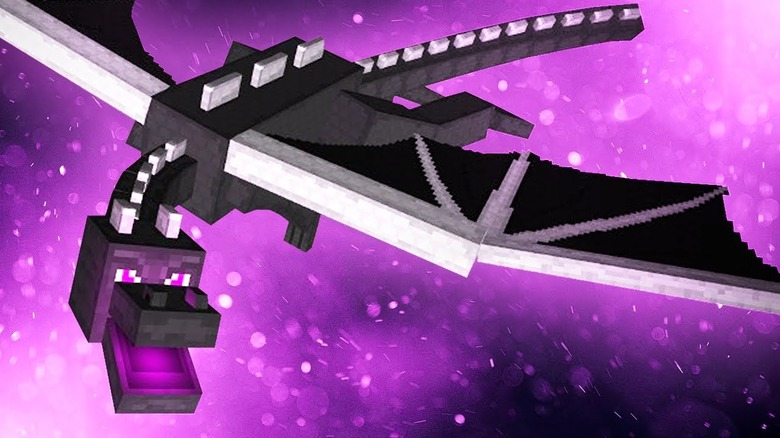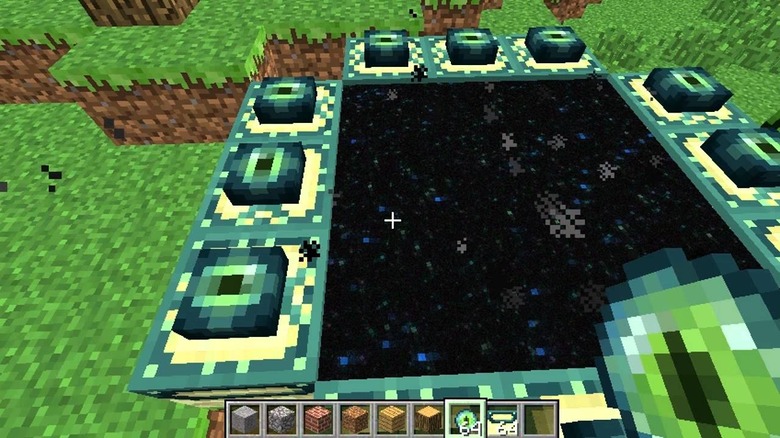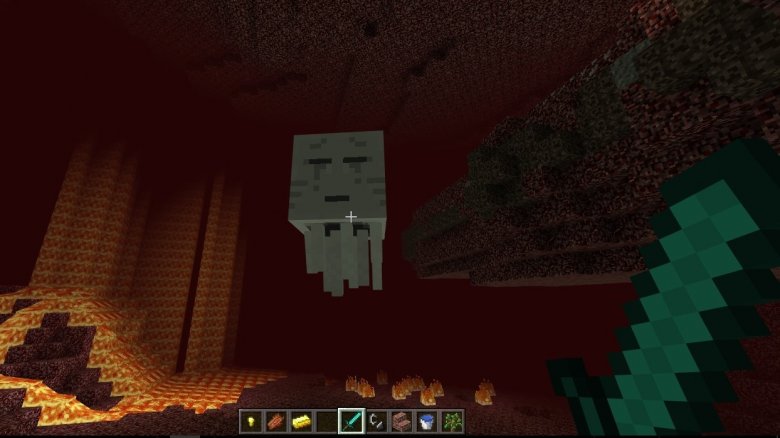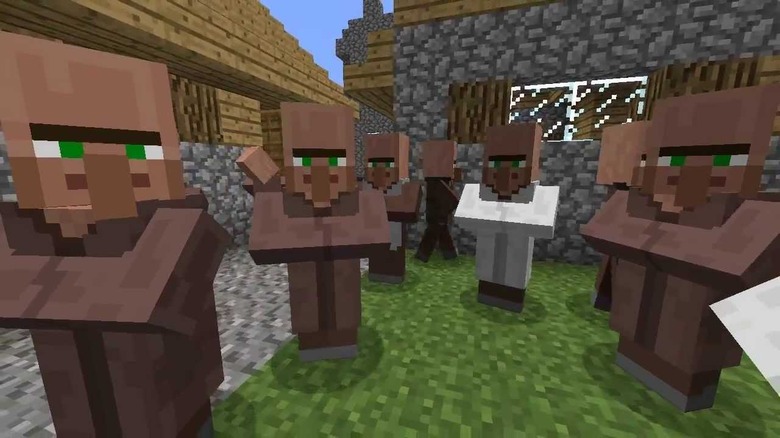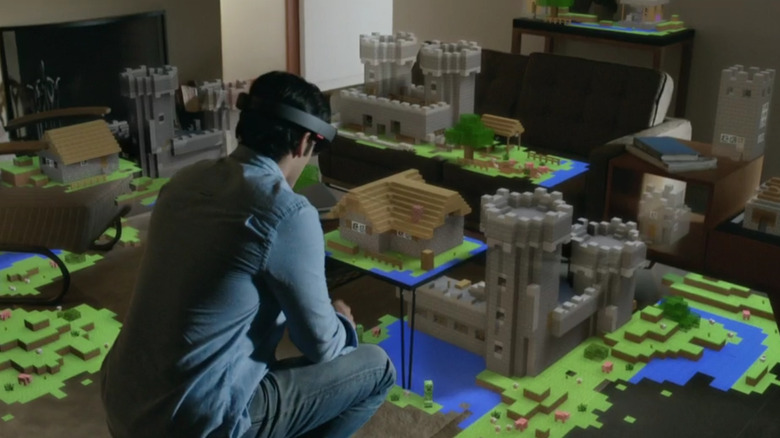The Ending Of Minecraft Explained
In life, we're told we can do anything we put our minds to. In Minecraft, players can do anything they put their pickaxe to. Since the game's release in 2011, the innumerable possibilities within the game have allowed players to explore open worlds; build their own cities, roller coasters, and computers; dabble in technology and magic alike; and create their own games, or working cell phones, along the way. There might be an endless amount of content within the pixels of Mojang's Minecraft, but there is also an end.
In a seemingly infinite open world where players get to tell their own stories, there is a finish line. As unlikely as it sounds, it's fairly easy to achieve, depending on players' patience and skill. The capital-E End to Minecraft has a rich reward and something for players' to ponder over as they bask in their victory, a mystery that still has the internet baffled to this day.
Yes, there is an End
The End to Minecraft is naturally occurring. Players in search of the end can find it by scouring any world that they find themselves in. In Survival mode, beneath the blocks of the earth are strongholds. There can be anywhere between one to 128 strongholds per world, and within the stone walls are passageways, iron bars, maybe a library or two. But the beginning of The End lies in the End portal found there.
In the End portal room is an empty well above a pit of lava made of twelve frames, each needing an eye of ender. Depending on how or where gamers are playing the game, throwing ender eyes in the air can lead them to one of these strongholds. Once there with at least twelve eyes of ender, the End portal can be opened. This unlocks the achievement with the worryingly questioning title "The End?"
It is indeed the End, should players continue forward from there. The End is the name of the dark, ethereal realm that the portal leads to. The ground there is made of endstone and between islands of this is nothing but void. There is no day or night, and beds will explode if you try to place them. Here is where the ender dragon dwells, and there is no escape until the player defeats it.
How to get there
Unless you're a speedrunner, a magician, or adept at finding glitches, you'll want to be prepared before facing a foe as indomitable as the ender dragon. Players first need to explore the underworld of the Nether before braving The End. While the Nether has literal fire and brimstone, traversing this hellscape will be a walk in the park compared to defeating the ender dragon.
To get to the Nether to get to the End, players will first have to make a Nether portal, which allows them to go back and forth from the Overworld. This requires obsidian blocks, which can only be mined with a diamond pickaxe. Once in the Nether, players have to avoid the powered up mobs like Ghasts and Blazes. Blazes will drop Blaze rods upon defeat and can be crafted into blaze powder.
Blaze powder is one half of the ingredients needed to create eyes of ender. Endermen drop ender pearls, rather than ender eyes. Killing a dozen or so endermen (if you can) and then combining their ender pearls with blaze powder will create an eye of ender. For the End portal, players will need twelve eyes to unlock its depths. While not a ridiculously arduous process, the journey toward crafting the ender eyes should prepare players for the battle ahead of them.
Why end an endless game?
Since the days of the very first 2D platformers, gamers have been taught that there's is a prize at the end, something to work your way jumping and punching and crafting through the world for. The other common wisdom that games follow to this day is that in order to obtain this prize, players will have to face their greatest challenge yet: the final boss. As much freedom that Minecraft affords players, it still follows this formula.
The ender dragon spawns as soon as players enter the unknowable dimension of The End. Big, black, and blocky with purple eyes, the dragon isn't too thrilled to have an intruder upon its inner world. Perhaps it knows that the player's only way out is through its defeat. The ender dragon can destroy any block by hitting it with its massive body and will deal some serious damage if it knocks into a player, which it will try to do. Beyond physical attacks, the ender dragon breathes fireballs and a noxious purple smoke that the most daring of players can try to bottle to obtain the item Dragon's Breath.
Once finally defeated, the dragon will drop from the sky, battleworn and crying out as beams of light overtake its physical form. Upon its death, the rarest item in the game spawns: the dragon egg. Only one dragon egg can generate per world, making it a seriously valuable, but otherwise useless item: the dragon egg is just a trophy. Congrats.
You can speedrun Minecraft
It might seem impossible, but there is a way to speedrun the game that encourages exploration, creativity, and building intricate structures for hours. Those who totally want to bypass the slow gain of materials, the satisfaction of crafting an iron pickaxe for the first time, and the excitement of their very first square-off with a creeper can race to the End in a matter of minutes.
The previous record for defeating the ender dragon stood at 3:20:9 which was achieved by speedrunner Illumina. Considering how some players can't even craft their first tool in that amount of time, it's a fast and a hard record to beat. Illumina had used a glitch found by user Geosquare, who later set a seemingly unbeatable 1:35:33 record.
Now, these players aren't going about Minecraft in the usual way: they're making use of program tools and glitches to go as fast as possible. Ilumina and Geosquare looked for the ideal conditions, contained within world seeds, in which to find what they need and use it, fast. They used a seed that allowed them to get through the overworld, spend a few moments in the Nether, teleport to the stronghold, and jump through the portal with an End Crystal in hand. Geosquare found a glitch to make the game assume the player has already defeated the dragon before the fight can even load.
The fastest run using only human reflexes and no glitches at all? That belongs to AlphaCreeps' 2:31 sprint, better even than Illumina's tool-assisted run.
The poem
You beat the ender dragon: then what? The credits roll, of course. But these aren't your average credits. The credits are perhaps the most mysterious part of Minecraft, and certainly more mysterious than even the murky world of the End.
Minecraft ends not in fire nor in ice, but in poetry. When the player exits the End, they're greeted with a blue and green scroll of text that addresses them directly as their PLAYERNAME. The poem is a dialogue, but it may as well be a podcast because it lasts nearly ten minutes. Two voices talk about how the player did a good job, how they have reached a whole new level, how they dreamed, how they woke, and how they were built of billions of atoms and how they sometimes spoke to the universe.
It's a strange, introspective ten minutes. The two speakers appear to be gods of some kind, or else beings on a wholly higher level of existence that the player is just brushing against. They seem to be waxing on the meaning of life, which they call the "long dream" as opposed to the "short dream of a game." All in all it's meta, the beings acknowledging that the player thinks they are part of the game, and confusing. Time would prove that the poem at the end was also highly controversial.
Is Notch a god?
Markus "Notch" Persson built the sandbox that is Minecraft in which players could invent their own worlds and adventures. Does that make him a god? Minecraft, for many, is more than just a game. The culture and creations made in Minecraft have had implications far beyond their blocky landscapes. Minecraft is where the seeds of new games have spawned, where internet personalities have made their marks, and where the name Notch is lauded above all else.
Notch has been called a god by various profiles written about him and even the Minecraft fandom seems to agree wholeheartedly with this terminology, creating fan art around the idea. Therefore, one theory about the end poem is that the gods of Minecraft might be Notch, the two halves of himself proudly speaking to the players of his own creation. He's on a different level, looking down upon the player who achieved the final achievement. The game is what he has made it to be, and the final poem is where he is able to give meaning to an experience with no solid story or moral.
While this theory hasn't been confirmed, we do know that it was Notch's idea to put the poem at the end, and he tasked the perfect poet for the job.
The poet
In 2011, Notch tweeted out a call to writers and creatives, asking for someone to write "silly over-the-top out-of-nowhere text" for his game. Julian Gough delivered. Gough had met Notch previously, but had no idea of the scope of what Minecraft would become. That game developer he had met didn't have an end for the game he was about to launch, so Gough lent his talents after several people recommended him.
Once chosen for the job, it began to dawn on Gough how big Minecraft was and how it was only going to get bigger after launch. Notch had given him total freedom, telling Gough to surprise him. They seemed to be on the same philosophical wavelength, so after the writer immersed himself in the game, he wrote the poem as we know it now: no second drafts. Notch didn't cut a single word.
In an interview for Boing Boing, Gough said that the end of the poem seemed to have written itself, as if the universe were writing through his hands as he watched on. This is immensely fitting, considering how central the idea of the universe speaking to the player is throughout the piece.
As for the poem's ultimate meaning? Gough said he wanted it to be dreamy, to capture the way Minecraft players can get lost in a game, and that the conversation was a type of enlightenment: he wanted players to feel like they'd broken through to something.
The internet reacts
In a way, Gough broke the internet with the ambiguousness of his poem. No one knew quite what to make of it upon encountering it for the first time, fresh from their victory over the ender dragon. The poet acknowledged that some people didn't dig the idea of sitting in front of mysterious text for a full ten minutes, but said that other people had gotten emotional, thanking him via social media for the experience.
Some have said that it is boring, citing short attention spans; others have said it made the game feel complete. Parts of the community find the end poem to be overly philosophical in a try-hard kind of way, that it almost gives the game a strangely religious undertone.
Religious websites, in fact, have claimed that the end poem is problematic. The Christian blog, The Berean Call, has cited the ending lines of the end poem as equating the player — not Notch — to God. There in the text, where the universe is speaking to the player, the player is the universe and therefore God. In the Boing Boing interview, Gough says that he believes computer games or other media can be religious-like experiences, but it's unlikely that he was trying to craft an actual new religion with the end poem.
Rather than whether or not the end poem is about the player being a god, the debate around the poem is much more meta.
Games vs reality: which is the poem about?
When it comes to theorizing on the end poem, it is the final line that is most striking: "Wake up."
This is fairly meta considering that it is at that moment when players become most aware of reality, "waking up" after having been immersed in the most intense part of the game. This interpretation of the poem theorizes that Minecraft is a dream, where in players create their own reality. Idyllic, but ultimately not the genuine article. Some say that the poem is prompting players to "wake up" from Minecraft and leave the game for the real world. Put down the controller and get some fresh air, as it were. Get a life.
In a Game Theory video, YouTuber and game theorist extraordinaire MatPat gets philosophical and details this theory, but also the opposite idea: reality is just a dream, and you made of it what you wanted to. In Minecraft. Confusing? Yes. Slightly more uplifting? Also yes. Here there doesn't seem to be the admonishment of players for ignoring reality, but rather the congratulations for their creation of their own world in-game.
The dark and twisted version
Life is what you make it: a very positive message to be sure. The poem is beautiful, waxing on about how the universe loves the player, and how the player is love. Some in the Minecraft community refuse to take the flowery prose at face value and have instead found something very sinister at the core of what appears to be an otherwise innocuous dialogue:
Satan. Or Herobrine. Whichever is worse.
In Minecraft, Herobrine is the creepypasta ghost that seems to haunt every aspect of the game. An empty-eyed version of Steve, Herobrine is creepier than any creeper, the alleged specter of Notch's brother or remnant of a tortured man. It's here the end poem comes into play. In Herobrine-centered hoaxes popularized by streamers, the idea is detailed that the story of Minecraft is about a tortured man who had retreated into a fantasy world to escape the pain. The hoax text is littered with pleas to WAKE UP, just like the final line of the end poem. So the theory follows that the end poem is reality bleeding through and begging with the dreaming Herobrine.
Perhaps, like life, the poem is what you make of it.

